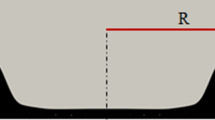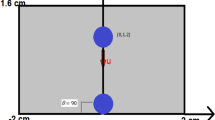Abstract
In this paper, a numerical solution for viscoelastic drop formation from a nozzle into an ambient gas is presented. A volume of fluid (VOF) method is used to predict the formation and break-up process of viscoelastic drop. Here, Giesekus model is used as the constitutive equation. The major features of the phenomenon, such as instantaneous drop length, limiting length of a drop at breakup, minimum drop radius and the volume of the primary drop is determined for a range of the parameter space spanned by the appropriate dimensionless groups. The results reveal that enhancing the mobility factor, Wiessenberg number, and viscosity ratio causes a noticeable decrease in limiting drop length and a small decrease on the primary drop volume. Also, the increasing of gravitational bond number and capillary number causes the limiting drop length increases while the primary drop volume is reduced.





















Similar content being viewed by others
References
Rezanka I, Eschbach R (1996) Recent progress in ink jet technologies: reprinted from IS & T proceedings and journal articles 1993–1995. Society for Imaging Science and Technology, Springfield
McKinley GH, Tripathi A (2000) How to extract the Newtonian viscosity from capillary breakup measurements in a filament rheometer. J Rheol 44:653
Kong S, Senecal P, Reitz R (1999) Developments in spray modeling in diesel and direct-injection gasoline engines. Oil Gas Sci Technol 54:197
Bailes P, Winward A (1972) Progress in liquid–liquid extraction. Trans Inst Chem Eng 50:240
Heideger W, Wright M (1986) Liquid extraction during drop formation: effect of formation time. AIChE J 32:1372
Mansour A, Chigier N (1995) Air-blast atomization of non-Newtonian liquids. J Non-Newton Fluid Mech 58:161
Fernando R, Xing L-L, Glass J (2000) Rheology parameters controlling spray atomization and roll misting behavior of waterborne coatings. Prog Org Coat 40:35
Rose D (1999) Microdispensing technologies in drug discovery. Drug Discover Today 4:411
Goldmann T, Gonzalez JS (2000) DNA-printing: utilization of a standard inkjet printer for the transfer of nucleic acids to solid supports. J Biomech Biophys Methods 42:105
Guthrie F (1863) On drops. Proc R Soc Lond 13:444
Rayleigh L (1899) XXXVI. Investigations in Capillarity: the size of drops: the liberation of gas from supersaturated solutions. Colliding jets. The tension of contaminated water-surfaces. Lond Edinb Dubl Philos Mag 48:321
Tate T (1864) XXX. On the magnitude of a drop of liquid formed under different circumstances. Lond Edinb Dubl Philos Mag 27:176
Edgerton H, Hauser E, Tucker W (1937) Studies in drop formation as revealed by the high-speed motion camera. J Phys Chem 41:1017
Zhang X, Basaran OA (1995) An experimental study of dynamics of drop formation. Phys Fluids 7:1184
Henderson DM, Pritchard WG, Smolka LB (1997) On the pinch-off of a pendant drop of viscous fluid. Phys Fluids 9:3188
Eggers J, Dupont TF (1994) Drop formation in a one-dimensional approximation of the Navier–Stokes equation. J Fluid Mech 262:205
Ambravaneswaran B, Wilkes ED, Basaran OA (2002) Drop formation from a capillary tube: Comparison of one-dimensional and two-dimensional analyses and occurrence of satellite drops. Phys Fluids 14:2606
Wilkes ED, Phillips SD, Basaran OA (1999) Computational and experimental analysis of dynamics of drop formation. Phys Fluids 11:3577
Chen AU, Notz PK, Basaran OA (2002) Computational and experimental analysis of pinch-off and scaling. Phys Rev Lett 88:174501
Yildirim OE, Basaran OA (2001) Deformation and breakup of stretching bridges of Newtonian and shear-thinning liquids: comparison of one-and two-dimensional models. Chem Eng Sci 56:211
Christanti Y, Walker LM (2001) Surface tension driven jet break up of strain-hardening polymer solutions. J Non-Newton Fluid Mech 100:9
Christanti Y, Walker LM (2002) Effect of fluid relaxation time of dilute polymer solutions on jet breakup due to a forced disturbance. J Rheol 46:733
Smolka LB, Belmonte A (2003) Drop pinch-off and filament dynamics of wormlike micellar fluids. J Non-Newton Fluid Mech 115:1
Davidson MR, Cooper-White JJ (2006) Pendant drop formation of shear-thinning and yield stress fluids. Appl Math 30:1392
Yildirim OE, Basaran OA (2006) Dynamics of formation and dripping of drops of deformation-rate-thinning and-thickening liquids from capillary tubes. J Non-Newton Fluid Mech 136:17
Aytouna M, Paredes J, Shahidzadeh-Bonn N, Moulinet S, Wagner C, Amarouchene Y, Eggers J, Bonn D (2013) Drop formation in non-Newtonian fluids. Phys Rev Lett 110:034501
Goldin M, Yerushalmi J, Pfeffer R, Shinnar R (1969) Breakup of a laminar capillary jet of a viscoelastic fluid. J Fluid Mech 38:689
Middleman S (1965) Stability of a viscoelastic jet. Chem Eng Sci 20:1037
Bousfield DW, Keunings R, Marrucci G, Denn MM (1986) Nonlinear analysis of the surface tension driven breakup of viscoelastic filaments. J Non-Newton Fluid Mech 21:79
Renardy M (2001) Self-similar breakup of a Giesekus jet. J Non-Newton Fluid Mech 97:283
Renardy M (2002) Similarity solutions for jet breakup for various models of viscoelastic fluids. J Non-Newton Fluid Mech 104:65
Renardy M (2004) Self-similar breakup of non-Newtonian liquid jets. Rheol Rev 2:171
Entov VM, Hinch EJ (1997) Effect of a spectrum of relaxation times on the capillary thinning of a filament of elastic liquid. J Non-Newton Fluid Mech 72:31
Chang HC, Demekhin EA, Kalaidin E (1999) Iterated stretching of viscoelastic jets. Phys Fluids 11:1717
McKinley GH (2005) Visco-elasto-capillary thinning and break-up of complex fluids. Rheol Rev 1:1–49
Amarouchene Y, Bonn D, Meunier J, Kellay H (2001) Inhibition of the finite-time singularity during droplet fission of a polymeric fluid. Phys Rev Lett 86:3558
Mun RP, Byars JA, Boger DV (1998) The effects of polymer concentration and molecular weight on the breakup of laminar capillary jets. J Non-Newton Fluid Mech 74:285
Oliveira MS, Yeh R, McKinley GH (2006) Iterated stretching, extensional rheology and formation of beads-on-a-string structures in polymer solutions. J Non-Newton Fluid Mech 137:137
Sostarecz MC, Belmonte A (2004) Beads-on-string phenomena in wormlike micellar fluids. Phys Fluids 16:L67
Tirtaatmadja V, McKinley GH, Cooper-White JJ (2006) Drop formation and breakup of low viscosity elastic fluids: effects of molecular weight and concentration. Phys Fluids 18:043101
Wagner C, Amarouchene Y, Bonn D, Eggers J (2005) Droplet detachment and satellite bead formation in viscoelastic fluids. Phys Rev Lett 95:164504
Clasen C, Eggers J, Fontelos MA, Li J, McKinley GH (2006) The beads-on-string structure of viscoelastic threads. J Fluid Mech 556:283
Oliveira MS, McKinley GH (2005) Iterated stretching and multiple beads-on-a-string phenomena in dilute solutions of highly extensible flexible polymers. Phys Fluids 17:071704
Shore HJ, Harrison GM (2005) The effect of added polymers on the formation of drops ejected from a nozzle. Phys Fluids 17:033104
Cooper-White J, Fagan J, Tirtaatmadja V, Lester D, Boger D (2002) Drop formation dynamics of constant low-viscosity, elastic fluids. J Non-Newton Fluid Mech 106:29
Keiller RA (1992) Extending filaments of an Oldroyd fluid. J Non-Newton Fluid Mech 42:37
Jones WM, Hudson NE, Ferguson J (1990) The extensional properties of M1 obtained from the stretching of a filament by a falling pendant drop. J Non-Newton Fluid Mech 35:263
Bhat PP, Basaran OA, Pasquali M (2008) Dynamics of viscoelastic liquid filaments: low capillary number flows. J Non-Newton Fluid Mech 150:211
Smolka LB, Belmonte A (2006) Charge screening effects on filament dynamics in xanthan gum solutions. J Non-Newton Fluid Mech 137:103
Davidson MR, Harvie DJ, Cooper-White JJ (2006) Simulations of pendant drop formation of a viscoelastic liquid. Korea-Aust Rheol J 18:41
German G, Bertola V (2010) Formation of viscoplastic drops by capillary breakup. Phys Fluids 22:033101
Hirt CW, Nichols BD (1981) Volume of fluid (VOF) method for the dynamics of free boundaries. J Comput Phys 39:201
Rusche H (2003) Computational fluid dynamics of dispersed two-phase flows at high phase fractions. Imperial College London (University of London)
Ubbink O, Issa R (1999) A method for capturing sharp fluid interfaces on arbitrary meshes. J Comput Phys 153:26
Bird RB, Armstrong RC, Hassager O (1987) Dynamics of polymeric liquids. Volume 1: fluid mechanics. A Wiley-Interscience Publication, Wiley, London
Larson RG (1988) Constitutive equations for polymer melts and solutions. Butterworths, Boston
Mirzadeh M, Sadeghy K (2008) On the role played by extensional behavior of Giesekus fluids in plane stagnation flow. J Soc Rheol 37:31
Jouyandeh M, Moayed Mohseni M, Rashidi F (2014) Forced convective heat transfer of Giesekus viscoelastic fluid in concentric annulus with both cylinders rotation. J Petrol Sci Technol 4:1
Li G, McKinley GH, Ardekani AM (2015) Dynamics of particle migration in channel flow of viscoelastic fluids. J Fluid Mech 785:486
Fontelos MA, Li J (2004) O the evolution and rupture of filaments in Giseskus and FENE models. J Non-Newton Fluid Mech 118:1
Calin A, Wilhelmb M, Balanc C (2010) Determination of the non-linear parameter (mobility factor) of the Giesekus constitutive model using LAOS procedure. J Non-Newton Fluid Mech 165:1564
Author information
Authors and Affiliations
Corresponding author
Rights and permissions
About this article
Cite this article
Komeili Birjandi, A., Norouzi, M. & Kayhani, M.H. A numerical study on drop formation of viscoelastic liquids using a nonlinear constitutive equation. Meccanica 52, 3593–3613 (2017). https://doi.org/10.1007/s11012-017-0669-2
Received:
Accepted:
Published:
Issue Date:
DOI: https://doi.org/10.1007/s11012-017-0669-2




